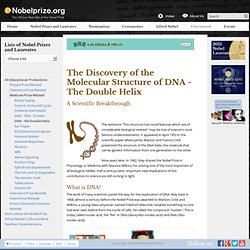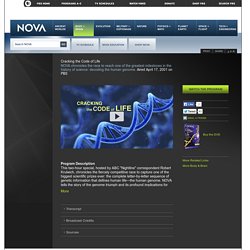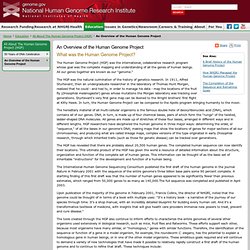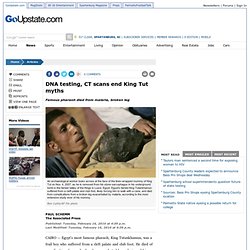

How DNA Was Discovered. A Scientific Breakthrough The sentence "This structure has novel features which are of considerable biological interest" may be one of science's most famous understatements.

It appeared in April 1953 in the scientific paper where James Watson and Francis Crick presented the structure of the DNA-helix, the molecule that carries genetic information from one generation to the other. Nine years later, in 1962, they shared the Nobel Prize in Physiology or Medicine with Maurice Wilkins, for solving one of the most important of all biological riddles. Half a century later, important new implications of this contribution to science are still coming to light. What is DNA? Was Rosalind Franklin Robbed? The views expressed are those of the author and are not necessarily those of Scientific American.

It’s remarkable what can happen when James Watson isn’t in the room. The Nobel laureate, known for his brilliance as well as his large ego and small superego, was expected to participate in a panel discussion Tuesday night about the play "Photograph 51," which focuses on Rosalind Franklin and her x-ray diffraction work in the early 1950s at King’s College London that contributed to discoveries of the molecular structure of DNA, first published in 1953. Watson, Francis Crick and Maurice Wilkins received the Nobel Prize in medicine or physiology in 1962 for this work, four years after Franklin’s death of ovarian cancer, possibly induced by her work with x-rays.
Nobels are only awarded to living scholars but a handful of researchers and advocates in the past few decades have argued that Franklin deserves more credit than she got for the DNA discovery. During that heady time. Cracking the Code of Life Video. Cracking the Code of Life PBS Airdate: April 17, 2001 ROBERT KRULWICH: When I look at this—and these are the three billion chemical letters, instructions for a human being—my eyes glaze over.

But when scientist Eric Lander looks at this he sees stories. ERIC LANDER (Whitehead Institute/MIT): The genome is a storybook that's been edited for a couple billion years. And you could take it to bed like A Thousand and One Arabian Nights, and read a different story in the genome every night. ROBERT KRULWICH: This is the story of one of the greatest scientific adventures ever, and at the heart of it is a small, very powerful molecule, DNA. For the past ten years, scientists all over the world have been painstakingly trying to read the tiny instructions buried inside our DNA. J. ROBERT KRULWICH: And what it's telling us is so surprising and so strange and so unexpected. ERIC LANDER: How different are you from a banana? Sequence DNA Virtual Lab.
An Overview of the Human Genome Project. An Overview of the Human Genome Project What was the Human Genome Project?

The Human Genome Project (HGP) was the international, collaborative research program whose goal was the complete mapping and understanding of all the genes of human beings. All our genes together are known as our "genome. " The HGP was the natural culmination of the history of genetics research. In 1911, Alfred Sturtevant, then an undergraduate researcher in the laboratory of Thomas Hunt Morgan, realized that he could - and had to, in order to manage his data - map the locations of the fruit fly (Drosophila melanogaster) genes whose mutations the Morgan laboratory was tracking over generations. The hereditary material of all multi-cellular organisms is the famous double helix of deoxyribonucleic acid (DNA), which contains all of our genes. The HGP has revealed that there are probably about 20,500 human genes. Of course, information is only as good as the ability to use it. Top of page Last Reviewed: November 8, 2012. DNA Replication and Protein Synthesis Model.
DNA Structure. Building DNA Lab. Journey Into Human DNA. DNA Extraction Virtual Lab. DNA Testing Completes Picture of king Tut. Two years of DNA testing and CT scans on Tut's 3,300-year-old mummy and 15 others are helping end many of the myths surrounding the boy king.

While a comparatively minor ruler, he has captivated the public since the 1922 discovery of his tomb, which was filled with a stunning array of jewels and artifacts, including a golden funeral mask. The study, which will be published Wednesday in the Journal of the American Medical Association, provides the firmest family tree yet for Tut. The tests pointed to Pharaoh Akhenaten, who tried to revolutionize ancient Egyptian religion to worship one god, as Tut's father.
His mother was one of Akhenaten's sisters, it said. Tut, who became pharaoh at age 10 in 1333 B.C., ruled for just nine years at a pivotal time in Egypt's history. The newest tests paint a picture of a pharaoh whose immune system was likely weakened by congenital diseases. King Tut Unwrapped : Videos.